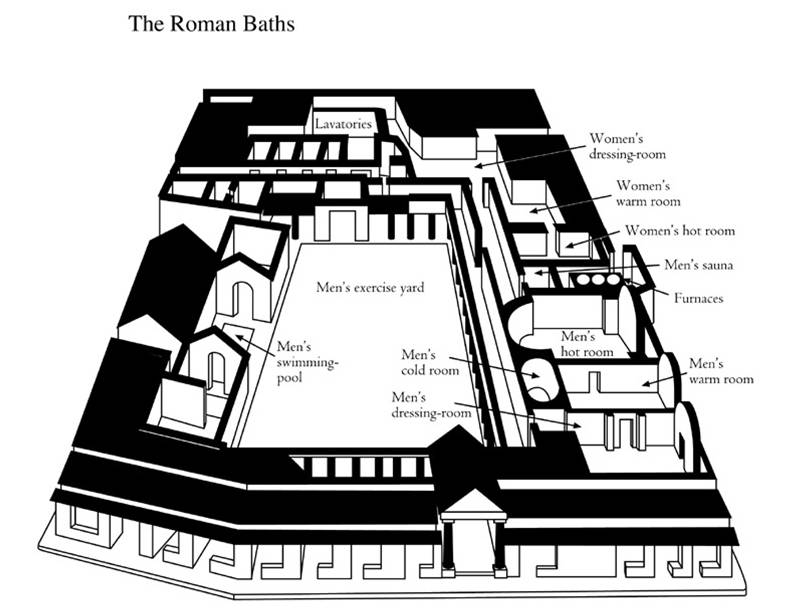|
|
 |
|
Baths & Bathing as an Ancient Roman |
|
written
by kjw2 / 09.13.2004 |
|
|
| |
Description |
| |
| |

|
|
| Floor Plan of the Stabian Baths |
| You can see on the floor plan that the Stabian Baths had separate facilities for men and women, a large palaestra and a laconicum. |
| |
|
| |

|
| from: <http://www.vroma.org/~bmcmanus/baths.html> |
| 3D plan of the Stabian Baths |
| This diagram gives you a better idea of what the Stabian Baths complex would have looked like in the early 1st century. |
| |
|
| |

|
| www.vroma.org/ ~bmcmanus/baths.html |
| Piscina at the Stabian Baths |
| This is the pool most like a modern swimming pool at the baths. It was shallow and was likely used only for light swimming. |
| |
|
There are three main public baths in Pompeii: the Forum Baths, the Central Baths and the Stabian Baths. All three baths were initially supplied water from the River Sarno and local wells, but later they were supplied by the aqueduct which brought water from the nearby hills. The Forum Baths were built in 80 B.C., close to the main forum, and were the smallest but most elaborately decorated of the three baths. The Central Baths were situated in the center of Pompeii and the Stabian Baths were situated at the junction between two of Pompeii’s main roads – the via dell’Abbondanza and the Via Stabiana and they are the oldest baths in Pompeii.
The Stabian baths, built at the end of the 2nd century, represent the earliest known use of the hypocaust. The Stabian baths are also important because they are some of the earliest and best preserved examples of baths from the republican period. The north wing dates back as early as the fourth century, but the double zones, with the palaestra, is from the second century. The circular laconicum was added during a restoration in 80 B.C. and was later turned into a frigidarium with the construction of the pool early in the 1st century. At the time of the eruption, most of the building was under construction; only the women’s section had been completely renovated. Most of this construction is probably because of the earthquake in 62 A.D., however, baths were constantly evolving, being updated and remodeled to keep with the trends of the time.
Both the Stabian and the Forum baths have separate facilities for men and women, which share a heating system. Few other baths throughout the empire had separate bathing facilities for men and women; it was more common (and certainly more cost effective) to have separate bathing hours for men and women. The women’s facilities are smaller and their apodyterium doubled as a figidarium, containing a small pool of cool water. Unlike later, larger and more elaborate baths in the Roman empire, the palaestra at the Pompeian baths doesn’t contain libraries or lecture halls to serve an educational purpose. The palaestra does contain a shallow (1-2 meter) piscina or pool and it is surrounded by a shady portico, where visitors could walk, talk and watch the exercisers. This piscina, like many others found in Roman baths, is too shallow and too short for competitive or rigorous swimming so it was probably was just used for leisurely activity. The Stabian baths, like other baths from the republican period, were simpler and darker than later, more elaborate bath houses. The philosopher Seneca contrasted “the overly lighted contemporary baths with the welcome darkness of the old ones such as the Stabian Baths or the Forum Baths in Pompeii” (Yegul 40). The Stabian baths thus offer us a well preserved snapshot of an early republican bath that laid the foundations for daily bathing to explode as a popular daily activity throughout the Roman empire.
|
| |
|
| |
|
|
 |
|



